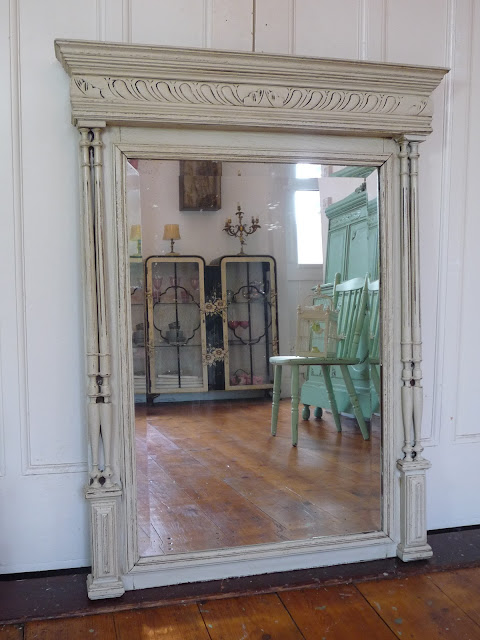As an online boutique specialising in authentic French furniture we stock a wide range of genuine, original pieces. Since beginning to import French lighting and antique furniture in 2011 we have learnt a great deal about these beautiful items, and what makes them special. We are passionate ambassadors for real French furniture (over cheaply made reproductions) and here we hope to share some of this passion and knowledge.
Below is a very brief guide to the wonderful world of French furniture, covering some of the the various items and styles a buyer is most likely to encounter:
Common Items of French Furniture
Buffet - a sideboard or dresser. French buffets are often extremely large. Single buffets tend to be very long with numerous drawers and cupboards. Two part bufets resemble dressers and are called Buffet et Deux Corps. Often the upper cupboard will have glazed doors.
Buffet - a sideboard or dresser. French buffets are often extremely large. Single buffets tend to be very long with numerous drawers and cupboards. Two part bufets resemble dressers and are called Buffet et Deux Corps. Often the upper cupboard will have glazed doors.
Commode - a French chest of drawers. The term commode means "comfortable" or "convenient". Introduced in the 17th century, these pieces are often very elaborate, with marble tops, gilding and painted decoration.
Bonnetiere - a narrow, tall single door French cupboard originally made to store bonnets.
Table de Chevet - a French bedside cabinet/table. Unlike British bedside cabinets which usually come in pairs, authentic antique chevets are singular items. Often with a marble top, small drawer and an inner cupboard.
French Painted Marble Top Table de Chevet
French Furniture Styles
As in British furniture each era generated a wealth of styles. Confusingly, unlike Victorian and Edwardian furniture, styles named after royalty don't necessarily date to individual reigns. Many overlap and have sub-divisions of styles, being sometimes more of a subtle evolution, than a revolution.
Louis - Probably the most recognisable, influencing modern British reproduction 'French style furniture'. Original Louis XV pieces date from around 1730 onwards, evolving into the Louis XVI style, beginning around 1760. These two styles of furniture often get grouped together under the simple umbrella of 'Louis'. Notable features include curved lines, cabriole feet and decorative motifs dominated by shell designs, birds and floral carvings.
Painted Louis Style Vintage Armoire
Henri II (1860-1900) - Also known as French Renaissance, Henri II furniture is notable for its size and solidity. Pieces tend to be huge and rectangular in composition, with heavy carving, dark wood and large bun feet. Armoires are notable for their often elaborate cornices with large finials and crests, and show a strong Italian influence in their carving and design. Mirrors and beds tend to be very ornate, with carved pillars and finials. Armoires have either solid wooden doors or glass mirror doors.
Henri II Style Armoire
Painted Henri II Style Mirror
Provincial/Country - Provincial furniture was made in the provinces, as opposed to the furniture made for the King and court in Paris. Court fashions often took a while to filter to the provinces, and as result French provincial furniture displays an array of overlapping styles. Most notable are pieces showing the influence of the countryside - woven rush chairs and simplified carving representing wheatsheaves and foliage. Pieces tend to be highly rustic in finish and style but beautifully made. Most notable are the huge armoires which are fully knockdown and held together with chunky, hand made wooden pegs.
Original Chestnut Provincial French Armoire
Breton - Breton furniture is highly distinctive. Often made of heavy, dark oak and highly carved, with fretwork a notable feature. Squares and rectangles predominate, with intensely carved human figures and faces, animals, plants and ships wheels. Maritime motifs also predominate, reflecting Brittany's close association with the sea. Armoires are often shorter than other styles and many come as bedroom sets with matching beds and pot cupboards.
Detail from Painted Breton Bed
Louis Philippe - Louis Philippe style French furniture emulates the furniture popular during the reign of Louis Philippe I (1830-1848). Known as the 'Citizen King', he was popular leading a less than lavish lifestyle and similarly the furniture named after him is beautiful for it's simplicity. These pieces epitomise elegance and tend to be less ornate and more refined than other styles. Armoires are recognisable by their wide cornice, tall body and raised feet. Like the Louis style, these are much imitated, but originals tend to be beautifully constructed and cleverly fully knockdown.
Louis Philippe Style Armoire
Who are we?
Dazzle Vintage Furniture is an online boutique specialising in authentic French furniture, lighting and accessories. We stock vintage armoires, French buffets, French vintage beds, antique mirrors and chandeliers. All our French furniture is original, vintage and imported directly from France.
Dazzle Vintage Furniture is an online boutique specialising in authentic French furniture, lighting and accessories. We stock vintage armoires, French buffets, French vintage beds, antique mirrors and chandeliers. All our French furniture is original, vintage and imported directly from France.













